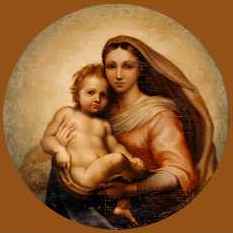

The de Brecy Tondo
The Sistine Madonna
[Comparative Detail within Hypothetical Circle]
Statement of Professor Howell Edwards, M.A., D.Phil., B.Sc., C.Chem., FRSC, Professor of Molecular Spectroscopy, University of Bradford:
"In September 2004 I undertook Raman spectroscopic analysis of paint samples from the de Brécy Trust's tondo painting of the Madonna and Child. The analysis found clear evidence of the use of the yellow (lead monoxide , PbO ) pigment massicot. This pigment is considered to be in pre-17th century usage by artists . The presence of lead white was also registered in the analysis . The analysis also indicated that the medium was not an oil or resin nor made from gum, animal glue or egg white. It is therefore most likely to be of a vegetable-derived, starch based glue (considered to be typical of Renaissance practice).
From these analytical findings, I am entirely confident that the tondo painting is consistent with an early, pre-1700, Renaissance work."
Latest Update: Since May 2012, further historical and technical research has been and continues to be undertaken. The historical research has related to the association of the de Brécy Tondo to the collection of Queen Henrietta Maria (1609-1669), wife of Charles I, to her Treasurer and Receiver General Sir Richard Wynn of Gwydir (1588-1649), and to the use of the tondo form in Renaissance art.
The technical research has focussed on the significance of the underdrawing and pentimenti and subsequently on the computerized facial recognition analysis of the Madonna and Child in the de Brécy Tondo by Professor Hassan Ugail, Director of the Centre of Visual computing at the University of Bradford, concluding that the de Brécy Tondo was 'undoubtedly' painted by Raphael.
